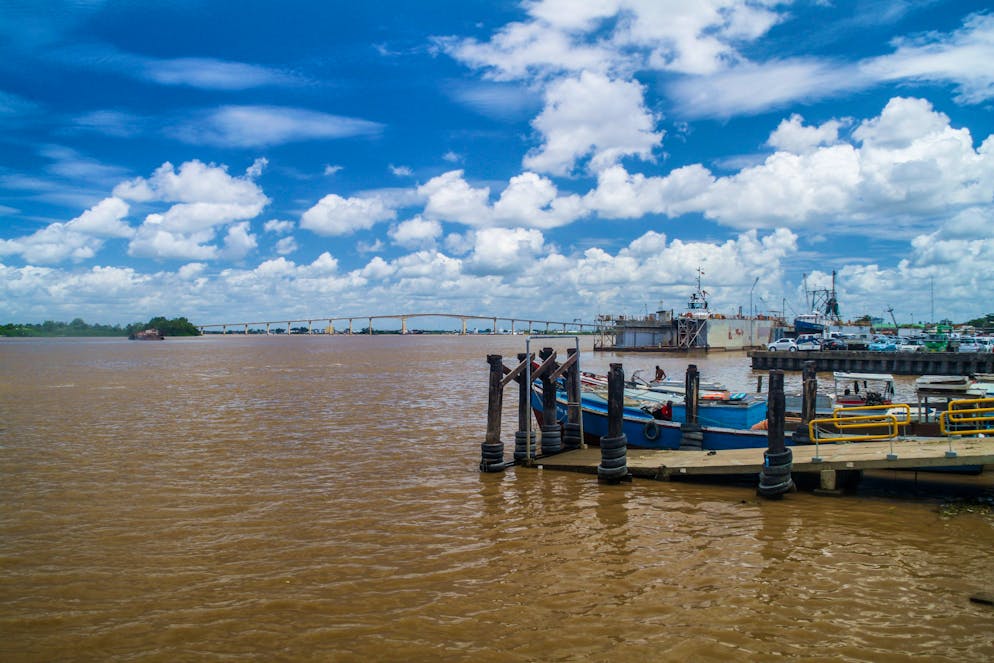“Each day, I see a piece of land disappear,” laments Gandat Sheinderpesad, a farmer from the Suriname threatened by coastal erosion. The urgency is such that the construction of dikes is the only remedy, in the short term, to protect the country and its capital Paramaribo.

IMAGO/Depositphotos
“Erosion has been a problem for many years in Suriname,” said AFP the Minister of Public Works, Riad Nurmohamed.
From his office in front of a map of the South American country of 600,000 inhabitants, he points to the different dikes erected over time over the 380 km of coastal zone.
In Suriname, 68% of the population lives in coastal areas of low altitude and is exposed to the rise in sea level, according to the IPCC, the group of climate experts mandated by the UN.
At the end of the capital’s estuary, where the brown waters of the Suriname river mingle with those, blue, of the Atlantic, still appears the island of Braamspunt. “A language of land which due to erosion today appears as an island,” observes Marleen Van Charante Stoffelen, head of WWF communication for Guyanes.
This is where come, maybe for the last time, lay marine turtles.
The island is inexorably reduced in the eyes of Kiran SOEKHOE BALRAMPERSAD, tourist guide. “Perhaps again next year, one more season,” he will earn a living by bringing in night tourists seeing turtles lute and green turtles, “but after that more beach,” he breathes.
“Nowhere to go”
In Suriname, “erosion accelerated so quickly that in 2020, it was necessary to ring the tocsin,” said Minister Nurmohamed.
“Some areas are not problematic because there are 5, 10, or even 20 kilometers of mangroves” which play the role of stamp. But “near Paramaribo, there is only one kilometer, it is therefore a very sensitive area”.
A Paletuviers planting program was launched five years ago but did not “market everywhere”. “Over the past two to three years, the water has entered the mangroves that have been destroyed,” said the minister.
In 2024, “it was necessary to act urgently (…) and launch the rapid construction of a dike to prevent water from penetrating more. Otherwise, she will very quickly reach the paramaribo zone ”.
Sienwnath Naqal, researcher at Anton de Kom University, specialist in climate change and water management, is at the origin of mangroves replanting projects.
“Here people have removed a lot from mangrove” in the past for agricultural crops and since then, “the buffer zone has been lost”, he points out, also evoking the dredging of sand at the entrance to the estuary to ensure the arrival at the port of the boats.
Near Paramaribo, he contemplates a large expanse of water on the roadside and the aligned wooden stakes where he had hung hundreds of shoots. The power of the waves, increased by global warming, has won the sediment substrate, putting their roots in the air.
The site where the UN secretary general, Antonio Guterres, had come to set foot in the mud in August 2022 to plant mangrove shoots, is now engulfed by the ocean.
It is up to Gandat Sheinderpesad, a 56 -year -old farmer, who says he has “no more work” because he has “lost 95% of the land”.
His house is just a few dozen meters from the new bank. The construction of a dike is his last hope. “I have nowhere to go. When there is the dike, I will be a little more safe. For how long, I don’t know. ”
“NOW”
At his side, Sienwnath Naqal says he is “sorry”. “I did my best with nature -based solutions” which in other places have worked very well, explains the expert. However, he is convinced that “the efforts made here will be for others on a global level”.
“But the question today is how to defend Paramaribo,” he reappears in the face of urgency.
The 4.5 kilometers of dike required, at a cost of $ 11 million, will be funded by the state.
“As it is urgent, it is on our own funds. If you will see donors, it will take years before you start construction. We do not have time to wait, we will be flooded, ”says the minister.
But the poor small country, which hopes from 2028 income from the Off-Shore oil exploitation, knows that it will have to multiply the protection plans.
“I do not know where we will find the funds necessary to improve all the dikes. It is a huge amount, a colossal investment. And this is a problem that we have to face now, ”says Mr. Nurmohamed.
